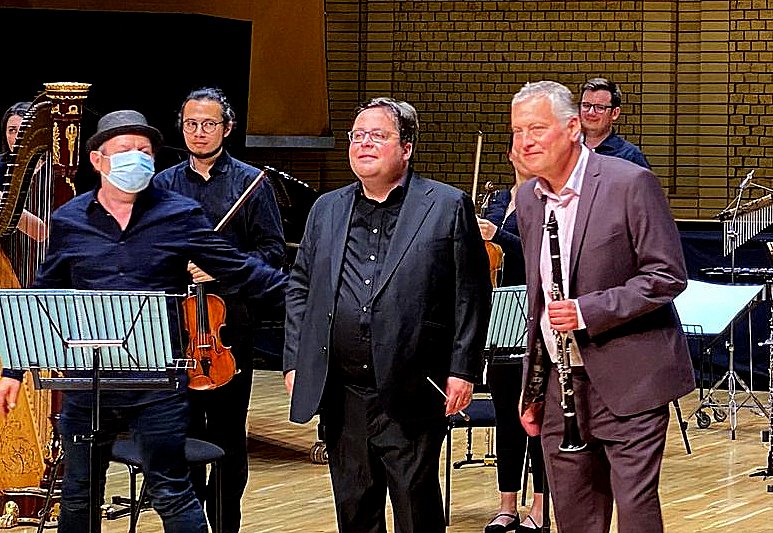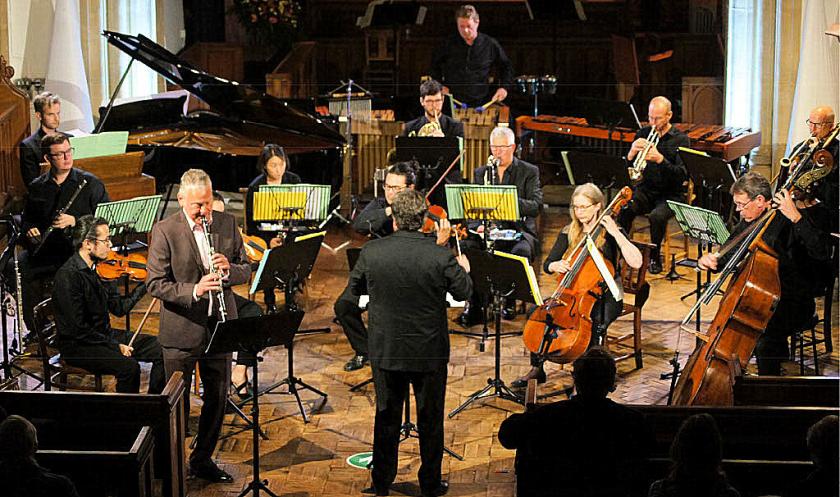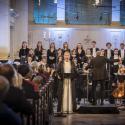Is there any composer alive who writes more luminously bittersweet elegies than Mark-Anthony Turnage? Taking key lines from memorialising poets through the ages as inspiration, he knows that instrumental phrases must sing, sometimes to invisible words, as well as dance if they’re to pierce the heart.
What more inspired choices could there be, then, to frame thornier works than This Silence of 1992/3 for mixed octet and a new Concertino for phenomenal, more-than-just-mellifluous clarinettist Jon Carnac, a musician Turnage loves and admires (he can’t compose unless such affinities pertain). It was receiving only its second performance in the leafy quietness of West Malling, a hidden treasure of Kent, and while the Birmingham Contemporary Music Group had already given the premiere in their home city, the gentle melancholy of a Sunday evening in the country poised between late summer and early autumn could not have been in better accord.
Their conductor on both occasions, Thomas Kemp, has been running Music@Malling for the past 11 years, taking risks with his programmes that few such rural festivals dare to emulate. One of those closely involved with events said to me after Kemp’s bracing pre-performance interview with Turnage that he doubted if there would be as many in the audience as there were in the ensemble. In fact there were many, many more, and, meeting some of the players afterwards on the station platform, I learnt that they felt the intensity and appreciated the very enthusiastic response.
 True, the filling of this Turnage sandwich (pictured right, the composer in pork pie hat and mask with Kemp and Carnac, first violinist Philip Brett behind, at the Birmingham premiere of the Concertino) was rather more typical BCMG hardcore territory. Eleanor Alberga’s On a Bat’s Back I do Fly had Shakespeare’s Ariel biffing around in high frequencies like a crazy moth, with more than a hint of Caliban in the melee, percussionist Julian Warburton working very hard indeed. Contrasting reflections could have done with reaching out a bit more to Turnage-style lyricism. Rebecca Saunders’ arcane abstractions in Stirrings worked surprisingly well in this context, pianissimos welcome given the amplifying qualities of St Mary’s Church. Her nine musicians placed from near to far distances, their instruments often unrecognisable, drifted with abundant overtones on the cusp of silence – a perfect realisation of the Beckett lines from which she took the title (none more apt than “Some soft thing softly stirring soon to stir no more”).
True, the filling of this Turnage sandwich (pictured right, the composer in pork pie hat and mask with Kemp and Carnac, first violinist Philip Brett behind, at the Birmingham premiere of the Concertino) was rather more typical BCMG hardcore territory. Eleanor Alberga’s On a Bat’s Back I do Fly had Shakespeare’s Ariel biffing around in high frequencies like a crazy moth, with more than a hint of Caliban in the melee, percussionist Julian Warburton working very hard indeed. Contrasting reflections could have done with reaching out a bit more to Turnage-style lyricism. Rebecca Saunders’ arcane abstractions in Stirrings worked surprisingly well in this context, pianissimos welcome given the amplifying qualities of St Mary’s Church. Her nine musicians placed from near to far distances, their instruments often unrecognisable, drifted with abundant overtones on the cusp of silence – a perfect realisation of the Beckett lines from which she took the title (none more apt than “Some soft thing softly stirring soon to stir no more”).
The human, on the other hand, is very much to the fore in both Turnage works. The source of lamentation in This Silence for clarinet, horn, bassoon and string quartet isn’t explicitly stated; the composer tells us only that the impetus and title came from Jon Silkin’s poem “Death of a Son” and that the second movement begins with an instrumental setting of the opening stanza to Henry King’s “The Exequy”.
The work begins and ends in poignant lyricism, though the opening “Dance” is kicked into extroversion by a memorable horn riff. Song and dance are equally balanced in the Concertino. The bittersweet second and fourth movements are respectively a Romanza for Carnac and his partner of 25 years Annette and a “Sad Soliloquy” (though not an unaccompanied solo) in memory of the clarinettist’s late parents ("a lot of my pieces are memorials," writes Turnage). Rhythmic and note-patterny fun and games come in the mostly mellifluous “Study in Fifths” and the third movement play on three of the five letters in “Carnac” – nothing to be done about the “n”. Carnac’s full tones could really stand out when needed, but for most of the Concertino he’s part of the team, another high compliment from friend to friend.














Add comment